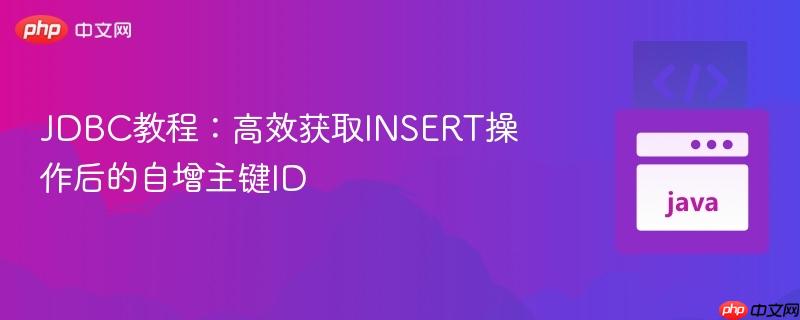
本文详细介绍了在jdbc中如何高效、准确地获取数据库`insert`操作后自动生成的自增主键(id)。针对传统方法无法直接返回自增id的问题,我们将重点讲解使用`preparedstatement`的`getgeneratedkeys()`方法,并提供示例代码,涵盖单行和批量插入场景,确保开发者能够可靠地获取新插入数据的唯一标识。
在数据库应用开发中,当向表中插入一条新记录时,如果该表的主键被设置为自增(例如PostgreSQL的SERIAL类型或IDENTITY列),我们经常需要在插入操作完成后立即获取这个由数据库自动生成的主键值,以便后续业务逻辑使用。然而,标准的JDBC Statement.execute() 或 Statement.executeUpdate() 方法通常只返回受影响的行数,并不能直接返回自增主键。尝试使用特定于数据库的SQL函数(如MySQL的last_insert_id()或PostgreSQL的CURRVAL/NEXTVAL)可能存在兼容性或准确性问题,且通常需要额外的查询,增加了代码的复杂性和维护成本。
JDBC API提供了一个标准且跨数据库兼容的机制来解决这个问题:PreparedStatement接口的getGeneratedKeys()方法。这个方法允许我们在执行完插入操作后,检索由数据库自动生成的所有键值,通常就是我们所需的自增主键。
要使用getGeneratedKeys(),我们需要在创建PreparedStatement时明确指示JDBC驱动程序应返回生成的键。这可以通过两种主要方式实现:
方法一:指定要返回的列名
在创建PreparedStatement时,可以传入一个字符串数组,其中包含你希望返回的自增列的名称。
import java.sql.Connection;
import java.sql.DriverManager;
import java.sql.PreparedStatement;
import java.sql.ResultSet;
import java.sql.SQLException;
public class SingleInsertGeneratedKeysExample {
public static void main(String[] args) {
// 数据库连接信息,请根据实际情况修改
String url = "jdbc:postgresql://localhost:5432/mydatabase";
String user = "myuser";
String password = "mypassword";
Connection connection = null;
PreparedStatement pstmt = null;
ResultSet keys = null;
try {
// 建立数据库连接
connection = DriverManager.getConnection(url, user, password);
String sql = "INSERT INTO the_table(some_column) VALUES (?)";
// 在创建PreparedStatement时,指定要返回的自增列名,例如"id"
// 确保 "id" 是你的表中自增主键的实际列名
pstmt = connection.prepareStatement(sql, new String[]{"id"});
pstmt.setInt(1, 100); // 设置some_column的值
int numRowsAffected = pstmt.executeUpdate(); // 执行插入操作
if (numRowsAffected > 0) {
keys = pstmt.getGeneratedKeys(); // 获取生成的键结果集
int newId = -1;
if (keys.next()) { // 移动到结果集的第一行(对于单行插入,通常只有一行)
newId = keys.getInt(1); // 获取第一个(也是唯一一个)生成的键值
System.out.println("新插入记录的ID: " + newId);
} else {
System.out.println("未获取到生成的ID。");
}
} else {
System.out.println("插入操作失败或未影响任何行。");
}
} catch (SQLException e) {
e.printStackTrace();
} finally {
// 确保在finally块中关闭所有JDBC资源,避免资源泄露
try {
if (keys != null) keys.close();
if (pstmt != null) pstmt.close();
if (connection != null) connection.close();
} catch (SQLException e) {
e.printStackTrace();
}
}
}
}方法二:使用 PreparedStatement.RETURN_GENERATED_KEYS 常量
这种方法更通用,它指示驱动程序返回所有自动生成的键,而无需指定具体的列名。
// ... (代码结构与上面类似,仅修改PreparedStatement的创建方式) // 创建PreparedStatement时,使用RETURN_GENERATED_KEYS常量 pstmt = connection.prepareStatement(sql, PreparedStatement.RETURN_GENERATED_KEYS); // ... (后续获取和处理ResultSet的步骤相同)
这两种方法在功能上是等效的,选择哪种取决于个人偏好或特定场景的需求。通常,使用PreparedStatement.RETURN_GENERATED_KEYS更为简洁。
当执行批量插入 (executeBatch()) 或单个SQL语句插入多行数据时,getGeneratedKeys()方法同样适用。在这种情况下,返回的ResultSet可能包含多个生成的键,因此需要使用循环来遍历所有结果。
import java.sql.Connection;
import java.sql.DriverManager;
import java.sql.PreparedStatement;
import java.sql.ResultSet;
import java.sql.SQLException;
import java.util.ArrayList;
import java.util.List;
public class BatchInsertGeneratedKeysExample {
public static void main(String[] args) {
// 数据库连接信息,请根据实际情况修改
String url = "jdbc:postgresql://localhost:5432/mydatabase";
String user = "myuser";
String password = "mypassword";
Connection connection = null;
PreparedStatement pstmt = null;
ResultSet keys = null;
try {
connection = DriverManager.getConnection(url, user, password);
connection.setAutoCommit(false); // 开启事务,确保批量操作的原子性
String sql = "INSERT INTO the_table(some_column) VALUES (?)";
pstmt = connection.prepareStatement(sql, PreparedStatement.RETURN_GENERATED_KEYS);
// 添加多条记录到批处理
for (int i = 0; i < 3; i++) {
pstmt.setInt(1, 200 + i);
pstmt.addBatch(); // 将当前参数组合添加到批处理中
}
int[] numRowsAffected = pstmt.executeBatch(); // 执行批量插入
List<Integer> generatedIds = new ArrayList<>();
keys = pstmt.getGeneratedKeys(); // 获取生成的键结果集
// 循环遍历所有生成的键
while (keys.next()) {
generatedIds.add(keys.getInt(1)); // 获取每个生成的键值
}
connection.commit(); // 提交事务
System.out.println("批量插入影响的行数: " + numRowsAffected.length);
System.out.println("所有新插入记录的ID: " + generatedIds);
} catch (SQLException e) {
try {
if (connection != null) connection.rollback(); // 发生异常时回滚事务
} catch (SQLException ex) {
ex.printStackTrace();
}
e.printStackTrace();
} finally {
// 确保在finally块中关闭所有JDBC资源
try {
if (keys != null) keys.close();
if (pstmt != null) pstmt.close();
if (connection != null) connection.close();
} catch (SQLException e) {
e.printStackTrace();
}
}
}
}通过利用PreparedStatement的getGeneratedKeys()方法,JDBC提供了一种强大、灵活且标准化的方式来获取INSERT操作后数据库自动生成的自增主键。无论是处理单条记录还是批量数据插入,该方法都能确保开发者高效、准确地获取所需的ID,从而简化应用程序逻辑并提高代码的健壮性。掌握这一技术是进行高效JDBC数据库编程的关键一步,它使得与自增主键的交互变得直观且可靠。
以上就是JDBC教程:高效获取INSERT操作后的自增主键ID的详细内容,更多请关注php中文网其它相关文章!

每个人都需要一台速度更快、更稳定的 PC。随着时间的推移,垃圾文件、旧注册表数据和不必要的后台进程会占用资源并降低性能。幸运的是,许多工具可以让 Windows 保持平稳运行。

Copyright 2014-2025 https://www.php.cn/ All Rights Reserved | php.cn | 湘ICP备2023035733号